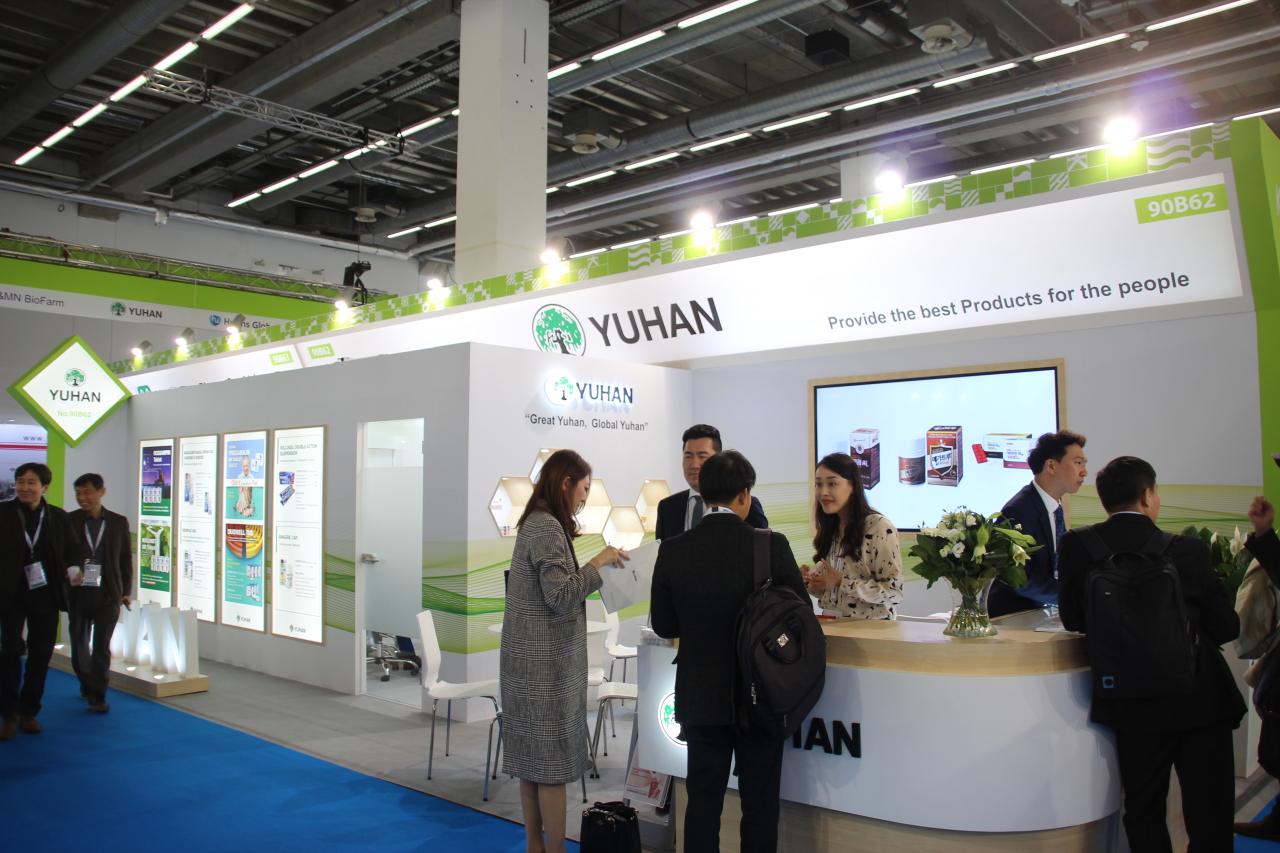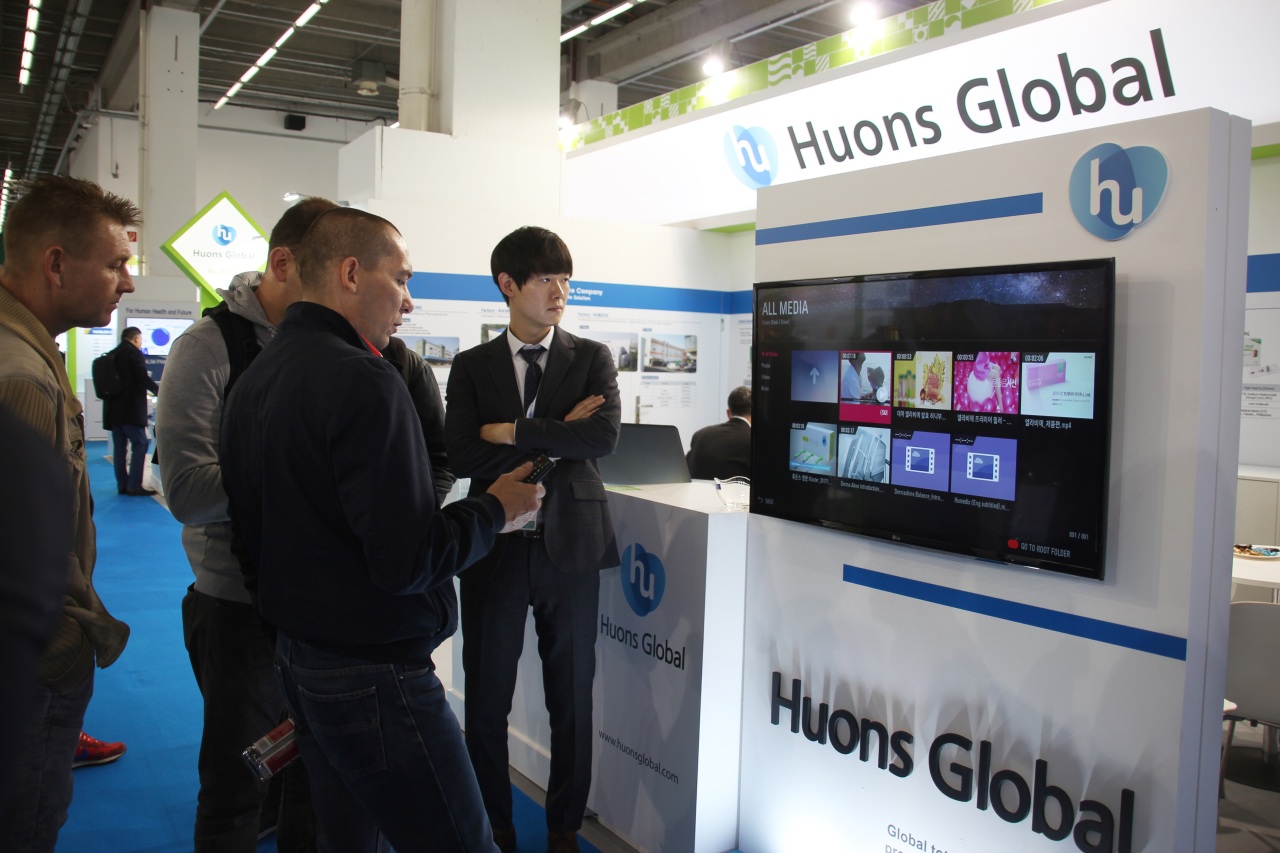Korean pharmas eye overseas expansion through CPhI
By Lim Jeong-yeoPublished : Nov. 7, 2019 - 12:06
FRANKFURT, Germany -- Korean pharmaceuticals’ participation in CPhI Worldwide continues to increase as the companies turn eyes to overseas trade in the face of domestic market limits.
At the Korea Pavilion for CPhI Worldwide 2019, created in joint effort by the Korea Pharmaceutical Traders Association and Korea Trade-Investment Promotion Agency, 35 firms opened booths to exhibit their products and hold business meetings with global clients.
The CPhI Worldwide 2019 was held from Tuesday through Thursday at Messe Frankfurt in Frankfurt, Germany.
Including the companies that opened individual booths, such as Samsung BioLogics and Daewoong Pharmaceutical, the number of Korean firms with booths goes up to around 70, or even more if Korean-owned international pharmaceutical body such as SK Pharmteco is counted.
European official of Samsung Bioepis was a panelist for a talk on the future of biosimilars, while others such as Celltrion opted to send representatives as event visitors without setting up booths.
“In the early years, not many Korean companies thought to utilize exhibitions as a means for overseas marketing. The domestic market had been enough, and export was not a big concern,” said Choi Yong-hee, team leader of export promotion at KPTA.
At the Korea Pavilion for CPhI Worldwide 2019, created in joint effort by the Korea Pharmaceutical Traders Association and Korea Trade-Investment Promotion Agency, 35 firms opened booths to exhibit their products and hold business meetings with global clients.
The CPhI Worldwide 2019 was held from Tuesday through Thursday at Messe Frankfurt in Frankfurt, Germany.
Including the companies that opened individual booths, such as Samsung BioLogics and Daewoong Pharmaceutical, the number of Korean firms with booths goes up to around 70, or even more if Korean-owned international pharmaceutical body such as SK Pharmteco is counted.
European official of Samsung Bioepis was a panelist for a talk on the future of biosimilars, while others such as Celltrion opted to send representatives as event visitors without setting up booths.
“In the early years, not many Korean companies thought to utilize exhibitions as a means for overseas marketing. The domestic market had been enough, and export was not a big concern,” said Choi Yong-hee, team leader of export promotion at KPTA.

“There has been a change in the attitude of Korean pharmas on how they perceive export,” Choi said, “Not only has the governmental support increased, but also there is a limit to the growth of domestic market. The cutback on rebates and lowered medication cost in Korea has prompted the Korean pharmas to seek more export chances.”
CPhI Worldwide 2019 first took place in 1990. The Korea Pavillion started to open from 1999. According to Choi, over the two decades KPTA and KOTRA joined the CPhI Worldwide events, the size of the Korea Pavilion has tripled.
On Wednesday, traders from Ethiopia and those from the Commonwealth of Independent States were the most common visitors at the Korea Pavilion.
Chong Kun Dang and Yuhan, both companies that have participated in CPhI Worldwide for around 10 years, said they were holding big volumes of both pre-arranged and walk-in business meetings.
Huons Global brought forth its dental anesthetic, eye drops, botulinum toxin and fillers, while Daewoong Pharmaceutical attracted clients with its Nabota BTX.


The Korean pharmaceutical market is growing at an average annual growth rate of 6 percent and is expected to mark $10.4 trillion in 2020.
Imports still outnumber exports in the Korean pharmaceutical market – most of the exports are to Southeast Asian countries, China and Japan rather than the more lucrative Europe and the US, Choi said.
In the end, the road to gaining pharmaceutical competitiveness comes down to the size of the investment on research and development.
International big pharma firms such as Bayer and Boehringer Ingelheim put in several trillions of won to R&D a year, while Korea has only a couple of companies that make an annual revenue of 1 trillion won.
One way the Korean government has stepped in to offer help was to join the international bodies for pharmaceutical quality control.
The Ministry of Food and Drug Safety, Korea’s health care regulator, joined the global Pharmaceutical Inspection Convention and Pharmaceutical Inspection Co-operation Scheme (PIC/S) in 2014, International Council for Harmonization of Technical Requirements for Pharmaceuticals for Human Use (ICH) in 2016 and the European Union’s Good Manufacturing Practice (EU GMP) in 2018.
Memberships with these groups ensures the quality of Korean pharmaceutical products in the eyes of the international players, said Kim Kwan-sung, the executive vice president at KPTA.
“In early ’70s, the main focus of Korean pharmas was active pharmaceutical ingredients, but as the environmental regulations toughened, the companies have shifted attention to value-added medicine.” The trend now among Korean pharma firms is a focus on finished products and value-added pharmaceutical ingredients that poses no environmental threat, explained Kim. giving examples of Korea’s biosimilar manufacturers Samsung BioLogics and Celltrion as the ones that are after VAM.
As the population aging intensifies across the world, the demand for senior health care will incrementally rise, which opens more possibilities for affordable generics, or biosimilars, Kim opined.
There will be the inevitable learning curve -- a splurge in the number of biotech and biopharmaceuticals companies will gradually sift out to leave only the real players to advance forward.
“If there is one thing the Korea bio market must overcome in order to grow further, it would be the investment,” Kim said.
Aggressive government investment is needed to foster the infrastructure and technology, and to educate the pool of future manpower. As for the companies, if they had previously put in an effort of 10 to overseas expansion, they must strive give 80, Kim urged.
Meanwhile, Goh Young-gon, the policy and regulatory affairs team manager from Korea Biomedicine Industry Association, delivered a session on the Korean biopharmaceutical market trends centering on recombinant protein products, vaccines and plasma derivatives, with the emergence of cell and gene therapy.
The next CPhI event is CPhI & P-MEC India from Nov. 26 through 28 in New Delhi, while the next CPhI Worldwide 2020 will be held in Milan, Italy from Oct. 13 through 15.
By Lim Jeong-yeo (kaylalim@heraldcorp.com)
Korea Herald correspondent







![[KH Explains] How should Korea adjust its trade defenses against Chinese EVs?](http://res.heraldm.com/phpwas/restmb_idxmake.php?idx=644&simg=/content/image/2024/04/15/20240415050562_0.jpg&u=20240415144419)










![[Today’s K-pop] Stray Kids to return soon: report](http://res.heraldm.com/phpwas/restmb_idxmake.php?idx=642&simg=/content/image/2024/04/16/20240416050713_0.jpg&u=)